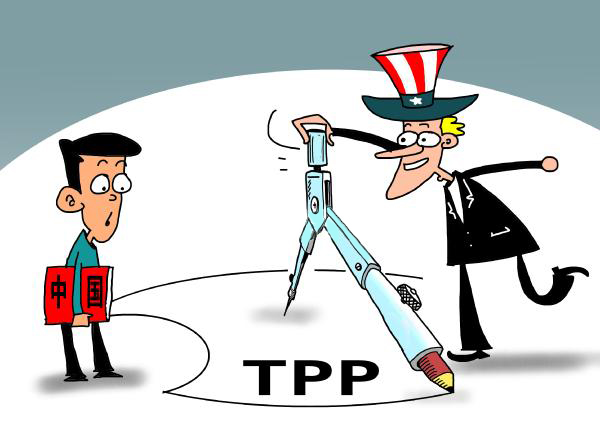GUAN XIULI: TPP unable to contain China

The Trans-Pacific Partnership Agreement (TPP), a new model for free trade dominated by the US, is more open than WTO trade liberalization. It has distinct characteristics, compared with previous free trade areas (FTAs).
First of all, TPP members are no longer confined to adjacent countries. TPP members are located throughout Asia, Oceania, Latin America and North America, while in traditional FTAs, trade cooperation is usually conducted between economies that are adjacent and similar in economic scale and development level.
The TPP also covers more topics than the WTO. In specific agreements, the US demands not only the comprehensive release of market access to goods and services but also calls for highly unified transaction rules governing such areas as competition policy, state-owned enterprises, government procurement, environmental standards and labor standards. Some are even higher than current standards in the US.
TPP content has high standards, broad coverage and elaborate design. For example, the TPP has made explicit stipulations for regulations on state-owned enterprise, indicating the US hopes to restrain the development of state-owned enterprises through investment competition policy.
Overall, TPP negotiations definitely favor US interests in terms of topic selection, standards and membership. It is also clear that the US is attempting to pursue maximum self-interest by pushing forward the TPP.
In recent years, the US has promoted a series of binding agreements centered on different topics. At the same time, it has attempted to boost the domestic standards of member states in aspects like trade, investment and globalization. However, it is hard for the TPP to rewrite the rules for international economic and trade investment.
China, one of the most important developing countries in the Pacific region, appears to have been purposefully elbowed out. This also reflects China’s influence and discourse advantage in this region. Therefore, the future development of the TPP depends on not only whether the US can aggregate the loose TPP alliance but also how China will accelerate the construction of “the Belt and Road” initiative, the Regional Comprehensive Economic Partnership (RCEP) negotiation and the negotiations for a trilateral FTA among China, Japan and South Korea.
For example, under “the Belt and Road” strategy, China is striving to gain the initiative in open cooperation, with a focus on the construction of economic cooperation belt and new types of FTAs. The RCEP negotiations, initiated and led by ASEAN, can further improve the East Asian production networks and relevant system arrangements. They enable each country to play a role in building a new international economic order. The proposed China-Japan-South Korea FTA will establish a comprehensive framework for trade, investment and cooperation among the three countries to enhance the overall development of regional economy. Meanwhile, China has become the biggest trading partner of many important countries involved in the TPP negotiations, including Japan, Singapore and Australia, and it is also the second-biggest trading partner of the US. It is early and groundless to say the TPP can contain or isolate China.
Currently, participants in economic globalization are increasingly diverse. China needs to comply with the development tendency of international trade rules, actively participate in the construction of the new international economic order, and learn from the experience of bilateral, regional and multilateral agreements. At the same time it must hold fast to the rights and interests of developing countries, defend achievements of the multilateral trading system and lead other developing countries in trade and investment cooperation. It is urgent for China and the US to take the lead in promoting global free trade in the process of jointly establishing a system of international rules for the 21st century.
Guan Xiuli is from the Institute of Foreign Economy at the National Development and Reform Commission.
